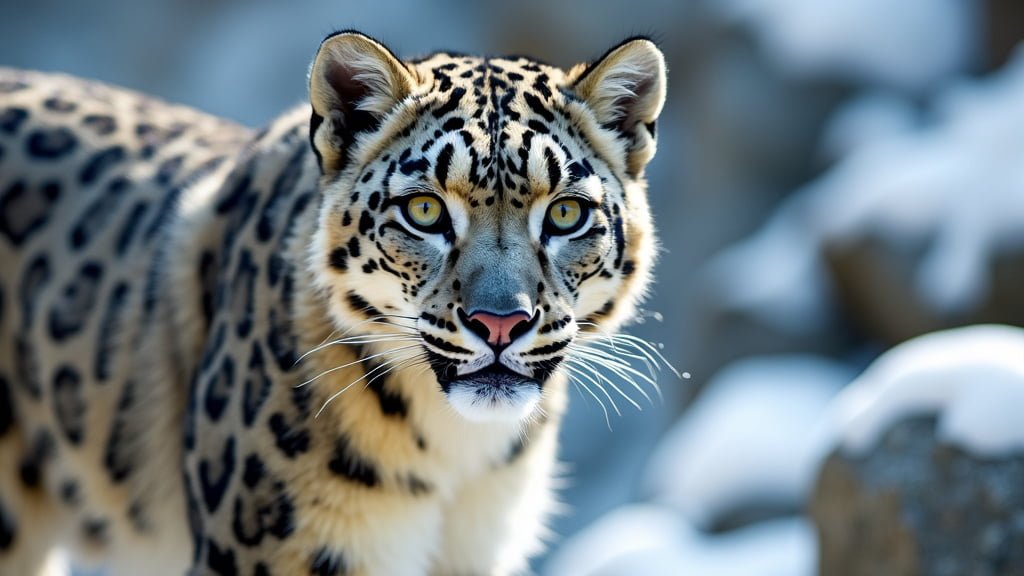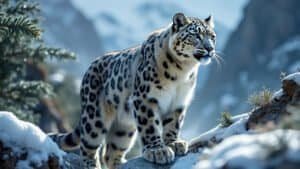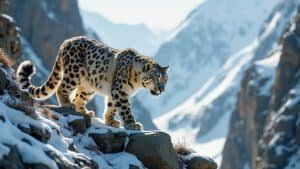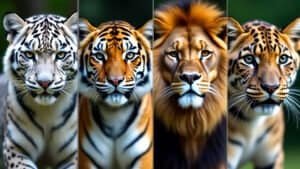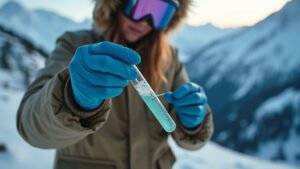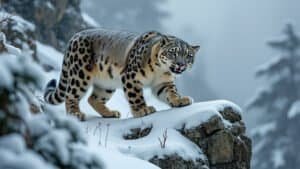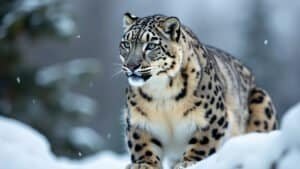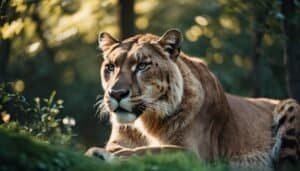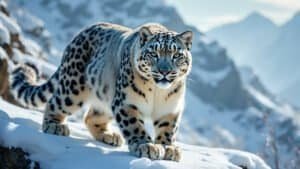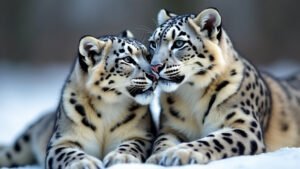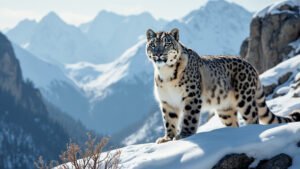Introduction
The snow leopard, known for its elusive nature and striking appearance, is a marvel of nature, with its coat color and pattern serving as both camouflage and a symbol of its wild heritage
This article delves into the genetic factors that influence the coat color and pattern of snow leopards, exploring the role of specific genes, inheritance patterns, and genetic mutations. By examining these elements, we can gain a deeper understanding of the diversity within snow leopard populations and the importance of these traits in their survival
The Role of Genes in Snow Leopard Coat Color
Genetic factors play a crucial role in determining the coat color of snow leopards, influencing not only the hue but also the specific patterns that make each individual unique
The genetic code of these magnificent big cats includes various genes that work together to produce the characteristic coat colors and patterns that help them blend into their mountainous environments
Understanding these genetic components is essential for conservation efforts, as it allows scientists to track population genetics and ensure the long-term survival of this endangered species
The Genetic Code: An Overview
The genetic makeup of snow leopards is composed of DNA sequences that encode the information required for the development of their distinct physical traits, including coat color. The genome of a snow leopard contains multiple genes that influence pigmentation
Among these, the Melanocortin 1 Receptor (MC1R) gene plays a pivotal role. MC1R is involved in the production of eumelanin (black or brown pigments) and pheomelanin (yellow or red pigments). Variations or mutations in the MC1R gene can lead to different colorations in the fur, contributing to the overall appearance of the snow leopard
Recent research has shown that the Agouti Signaling Protein (ASIP) gene also plays a significant role in determining coat color. The ASIP gene interacts with the MC1R gene to control the distribution of eumelanin and pheomelanin across the leopard’s coat
This interaction is crucial for the development of the characteristic rosette patterns seen in snow leopards, as well as the overall color balance between the darker and lighter areas of the fur
Key Genes Involved in Coloration
Several key genes have been identified as major contributors to the coloration of snow leopard coats. Besides MC1R and ASIP, the Tyrosinase (TYR) gene is another important factor
The TYR gene is responsible for the initial steps in melanin production, the pigment responsible for coloring the hair, skin, and eyes. Mutations in the TYR gene can lead to changes in melanin production, resulting in different shades of coat color
Additionally, research on big cats, including snow leopards, has identified the role of the KIT gene, which is involved in the migration and survival of melanocytes, the cells responsible for producing melanin. Variations in the KIT gene can influence the density and distribution of pigmentation in the fur, leading to subtle or significant variations in color
Another critical gene is SLC24A5, which has been linked to pigmentation in various species, including humans. In snow leopards, variations in this gene might contribute to the subtle differences in coat color observed across different populations
This genetic diversity is essential for the adaptability of snow leopards to their varied environments, from rocky mountain outcrops to snowy landscapes
Case Studies on Snow Leopard Color Variations
Studies conducted on different populations of snow leopards across their range—from the Himalayas to the Altai Mountains—have revealed interesting variations in coat color that can be linked to genetic differences
For example, snow leopards in the western part of their range tend to have slightly darker coats with denser rosette patterns, while those in the eastern regions may exhibit lighter coats with less pronounced markings. These differences are believed to be a result of genetic adaptations to the specific environmental conditions in these areas, such as altitude, temperature, and prey availability
One notable study published in the Journal of Mammalogy (2019) explored the genetic basis of these variations by analyzing the DNA of snow leopards from different regions
The study found that specific alleles associated with the MC1R and ASIP genes were more prevalent in populations with darker or lighter coats, respectively. These findings suggest that natural selection may favor certain coat colors in specific environments, enhancing the leopards’ ability to hunt and survive
Understanding the genetic factors that influence snow leopard coat color is not only important for scientific knowledge but also for conservation efforts. By identifying the genetic diversity within snow leopard populations, conservationists can make more informed decisions about breeding programs and habitat protection, ensuring that the unique genetic traits of these big cats are preserved for future generations
Understanding Coat Patterns in Snow Leopards
The intricate patterns on a snow leopard’s coat are more than just a beautiful display; they serve as essential camouflage in the leopard’s rugged habitat
These patterns are the result of complex genetic interactions that control the distribution of pigments across the fur, creating the rosettes and spots that are characteristic of snow leopards. Understanding how these patterns are formed at a genetic level provides valuable insight into the species’ evolution and adaptation to their environment
Genetic Mechanisms Behind Rosette Formation
Rosette patterns on snow leopards are a result of a precise balance between pigment production and distribution, which is governed by several genetic factors
The genes responsible for creating these patterns are part of a broader category known as pigmentation genes, which include those that control the type, amount, and distribution of melanin in the fur. The interaction between these genes determines whether the pigments form solid patches, like spots or stripes, or more complex shapes like rosettes
The Tabby gene (also known as Taqpep) has been identified as a critical gene involved in the patterning of fur in felines, including snow leopards. This gene influences the spatial distribution of pigments, contributing to the formation of the rosette patterns unique to each leopard
Studies in domestic cats, which share similar genetic mechanisms with wild cats, have shown that mutations in the Tabby gene can lead to a variety of coat patterns, from striped to spotted, and even rosetted patterns like those seen in snow leopards
Another important gene is Edn3 (Endothelin 3), which is involved in the development of melanocytes, the cells responsible for pigment production. The distribution of these cells during development is crucial for the creation of distinct patterns
In snow leopards, variations in Edn3 activity can lead to differences in the size, shape, and arrangement of the rosettes across their bodies
The Influence of Inheritance on Coat Patterns
Coat patterns in snow leopards are not only determined by the genes an individual inherits but also by how these genes are expressed during development
The inheritance of coat pattern genes follows Mendelian principles, where specific alleles (gene variants) are passed from parents to offspring. However, the expression of these alleles can be influenced by other factors, leading to a wide variety of patterns even within the same family group
The inheritance of the Tabby gene and other pattern-related genes can result in offspring with similar or entirely different patterns from their parents, depending on the combination of alleles inherited. For example, a snow leopard with highly defined rosettes may pass on genes that lead to a more muted pattern in its offspring, especially if the other parent carries alleles for less pronounced markings
Moreover, epigenetic factors—non-genetic influences on gene expression—can also play a role in determining coat patterns. These factors can include the mother’s health during pregnancy, environmental conditions during development, and even social factors within the leopard’s habitat
This complexity makes the study of coat patterns not only a matter of genetics but also of understanding the broader ecological and biological context in which these animals live
Environmental Interactions with Coat Patterns
While genetics provide the blueprint for a snow leopard’s coat patterns, environmental factors can influence how these patterns develop and are expressed. For instance, the altitude and climate of a snow leopard’s habitat can affect the density and color contrast of its fur
In colder, snowier environments, leopards may evolve lighter, less contrasted patterns that blend better with their surroundings, while those in rockier areas might develop darker, more pronounced markings
The process of natural selection plays a crucial role in this context. Snow leopards with coat patterns that offer better camouflage in their specific environment are more likely to survive and reproduce, passing on their genes to the next generation
Over time, this leads to a population where the most effective patterns become more common, reflecting the environmental pressures of the region
Research published in Molecular Ecology (2017) highlights the interaction between genetic and environmental factors in determining coat patterns. The study found that snow leopards in different parts of their range exhibited variations in pattern density and rosette size that correlated with environmental variables such as altitude, vegetation cover, and prey availability
These findings underscore the importance of considering both genetic and environmental factors in understanding the evolution of snow leopard coat patterns
The Impact of Genetic Mutations on Snow Leopard Fur
Genetic mutations play a significant role in the diversity of coat colors and patterns seen in snow leopards. These mutations can alter the expression of key genes involved in pigmentation and pattern formation, leading to variations that may either enhance or diminish the leopard’s ability to blend into its environment
Understanding these mutations is crucial for both evolutionary biology and conservation efforts, as they provide insights into how snow leopards have adapted to their habitats over time
Common Genetic Mutations and Their Effects
Mutations in the genes responsible for coat color and pattern can lead to a range of effects, from subtle changes in shade to more dramatic alterations in pattern formation. One of the most studied mutations is in the MC1R gene, which influences the type and amount of melanin produced in the fur
A mutation in this gene can shift the balance between eumelanin and pheomelanin, resulting in a lighter or darker coat. In some cases, MC1R mutations have been linked to the development of unusual color variants, such as melanistic (completely black) or leucistic (very pale) individuals
Another gene where mutations can have significant effects is the ASIP gene. Mutations in ASIP can disrupt the normal signaling pathways that regulate pigment distribution, leading to aberrant patterns or even solid-colored coats. Such mutations, while rare, have been documented in other big cats and are believed to occur in snow leopards as well
Mutations in the KIT gene, which affects melanocyte development and survival, can also lead to variations in coat color and pattern. For instance, a mutation that reduces the number of melanocytes in the skin can result in lighter-colored patches or even areas of complete depigmentation
These changes can create a piebald appearance, though this is more commonly seen in domestic animals than in wild populations like snow leopards
Case Studies: Mutations Leading to Unique Patterns
There have been several documented cases of snow leopards exhibiting unique or atypical coat patterns, believed to be the result of genetic mutations. One such case involved a snow leopard observed in the Altai Mountains with an unusually pale coat and very faint rosettes
Genetic analysis suggested that this individual had a mutation in the TYR gene, which plays a critical role in melanin production. The mutation likely reduced the production of both eumelanin and pheomelanin, resulting in the pale, ghostly appearance
Another intriguing example is the occurrence of melanism, a condition where an animal’s coat is completely black due to excessive eumelanin production. While melanism is relatively common in other big cats, such as leopards and jaguars, it is extremely rare in snow leopards
However, there have been anecdotal reports of melanistic snow leopards, suggesting that mutations in the MC1R gene or other related pathways could occasionally give rise to this condition
These unique cases highlight the role of genetic mutations in generating diversity within snow leopard populations. While most mutations are likely to be neutral or even detrimental, some can provide advantages in specific environments, contributing to the overall adaptability of the species
Implications for Snow Leopard Conservation
Understanding the genetic mutations that influence snow leopard coat color and pattern is not only important for scientific research but also for conservation efforts
Genetic diversity within snow leopard populations is a key factor in their ability to adapt to changing environments, whether due to climate change, habitat loss, or other pressures. By identifying and preserving this diversity, conservationists can help ensure that snow leopards retain the genetic tools they need to survive in the wild
Moreover, knowledge of these genetic mutations can inform captive breeding programs, where maintaining a diverse gene pool is crucial for the long-term health and viability of the species. In captivity, avoiding inbreeding and ensuring a broad representation of genetic traits can help protect against the loss of rare and potentially beneficial mutations
In a broader context, the study of genetic mutations in snow leopards also contributes to our understanding of evolutionary processes. By examining how certain mutations have spread or been maintained in wild populations, researchers can gain insights into the evolutionary pressures that have shaped the species over time
This information can then be used to make more informed decisions about conservation strategies, both for snow leopards and for other endangered species facing similar challenges
Conclusion
The coat color and pattern of snow leopards are not merely aesthetic traits; they are the result of complex genetic interactions that play a critical role in the survival and adaptation of this elusive species
Through the interplay of key genes like MC1R, ASIP, TYR, and others, snow leopards develop the unique patterns and colors that allow them to blend into their mountainous environments. These genetic factors are influenced by both inheritance and mutations, which can result in a wide variety of coat appearances within the species
Furthermore, the interaction between genetic and environmental factors demonstrates the dynamic nature of evolution in snow leopards, with natural selection favoring those individuals whose coat patterns best suit their habitats
Understanding these genetic mechanisms not only enhances our knowledge of snow leopard biology but also informs conservation strategies aimed at preserving the genetic diversity that is vital for the species’ continued survival
By studying the genetic basis of coat color and pattern in snow leopards, researchers and conservationists can gain valuable insights into the evolutionary history of these animals, helping to protect them in the face of ongoing environmental challenges
As we continue to learn more about the genetic factors that shape the appearance of snow leopards, we can better appreciate the intricate balance between nature and genetics that sustains one of the world’s most iconic and endangered big cats
